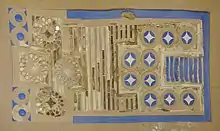Knossos board game
The Knossos board game (Greek: Ζατρίκιον; zatrikion) is a unique archaeological object belonging to the Minoan civilization that is preserved in the Archaeological Museum of Heraklion.

It was found by Arthur Evans in the archaeological excavations of Knossos, in an area to the northeast of the palace that has since been called the "corridor of the zatrikion". It is dated to the time of the second palaces (between 1700 and 1500 BC). It is a rectangular piece, made on a wooden base with valuable materials such as ivory, rock crystal, glass paste, gold and silver.[1]
Four cone-shaped ivory pieces were found next to the board, which were probably part of the game.
References
- Eli (2017-11-12). "Knossos Game – Zatrikion". Ancient Games - Playing the Board Games of the Ancient World. Retrieved 2021-12-26.
Further reading
- Arthur Evans: "The Palace of Knossos". In: The Annual of the British School at Athens. Vol. 7, 1901, The Royal Gaming Board, pp. 77–82
- Arthur Evans: The Palace of Minos. Vol. 1. Macmillan, London 1921, pp. 463–485
- Robert S. Brumbaugh: "The Knossos Game Board". In: American Journal of Archaeology. Vol. 79, No. 2, 1975, pp. 135–137, JSTOR:503893
- Ulrich Schädler: "Spielen im Labyrinth des Minotaurus?" In: Fachdienst Spiel. Nr. 2/96, 1996, pp. 6–14
This article is issued from Wikipedia. The text is licensed under Creative Commons - Attribution - Sharealike. Additional terms may apply for the media files.